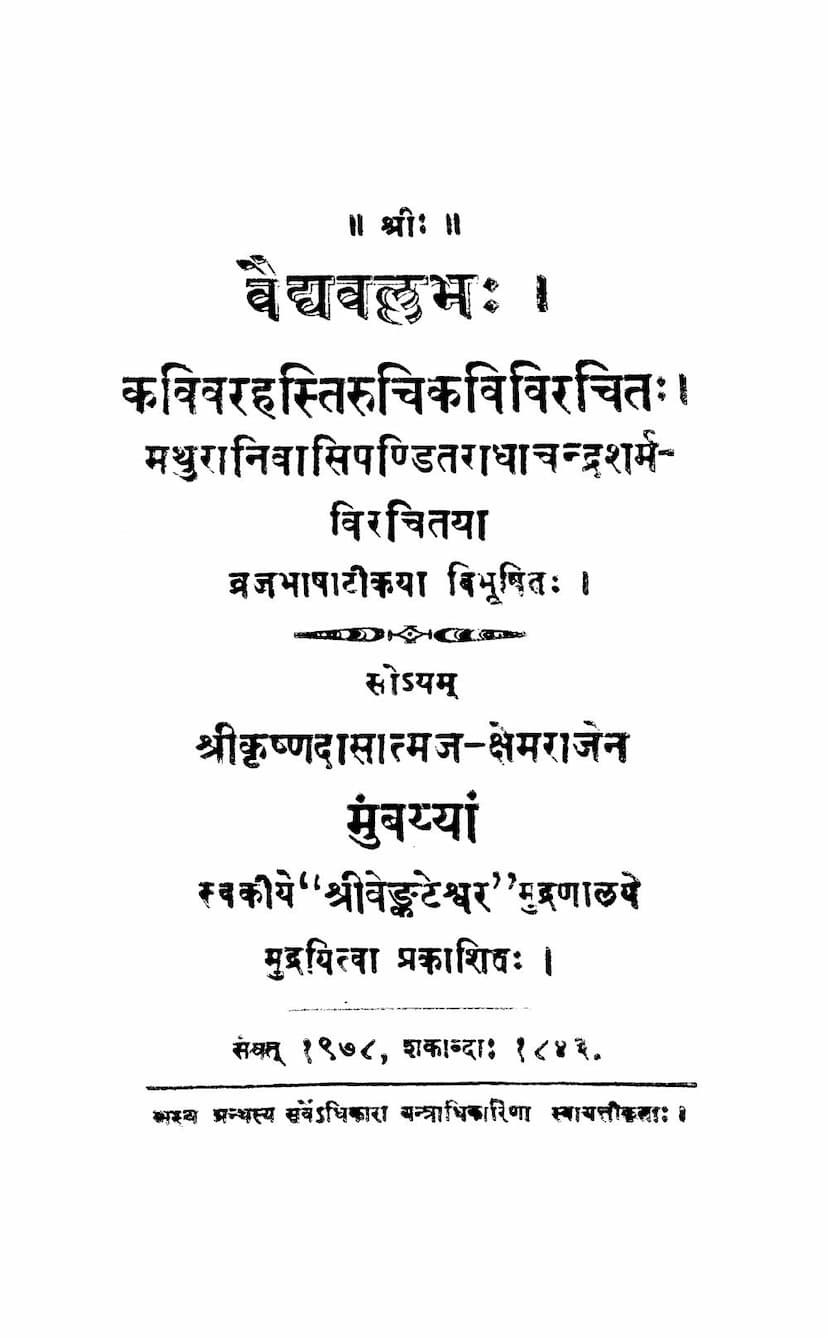Vaidyavallabh
Added to library: September 2, 2025

Summary
The provided text is a Jain manuscript titled Vaidyavallabh (वैद्यवल्लभ), authored by Hastikruchi Kavi (हस्तिक्रुचि कवि) and published by Khemraj Shrikrishnadas at the "Shri Venkateshwar" press in Mumbai. It is dated Samvat 1978 (1846 AD). The text includes a commentary in Vraj Bhasha by Pandit Radhachandra Sharma of Mathura.
The manuscript is a comprehensive treatise on Ayurveda, covering a wide range of diseases and their treatments. It is structured into nine sections, or Vilas (विलास), each focusing on specific ailments and remedies.
Here's a breakdown of the content based on the provided pages:
Overall Structure and Content:
- Vaidyavallabh (वैद्यवल्लभ): The title itself translates to "The Beloved of Physicians" or "The Darling of Physicians," suggesting its importance and utility in the medical field.
- Author: Hastikruchi Kavi, a respected poet and physician.
- Commentary: Vraj Bhasha commentary by Pandit Radhachandra Sharma, making the Sanskrit text accessible to a wider audience.
- Publisher: Khemraj Shrikrishnadas, a prominent publisher of Jain and religious texts.
- Table of Contents (अनुक्रमणिका): The document begins with a detailed table of contents, outlining the various topics covered in each section.
Key Sections (Vilas) and Their Contents:
The manuscript is divided into nine sections (Vilas), detailing various treatments:
-
Prathamo Vilas (प्रथमो विलास): Focuses on the treatment of fevers (ज्वर). It lists various types of fevers like fever due to bile (पित्तज्वर), phlegm (कफज्वर), wind (वातज्वर), wind and bile (वातपित्तज्वर), phlegm and bile (कफपित्तज्वर), cold fever (शीतज्वर), quartan fever (चातुर्थिकज्वर), fever from celestial causes (देवदोषज्वर), intermittent fever (एकान्तरज्वर), and complete fever (सन्निपातज्वर). It describes various decoctions (काथ), pastes (लेप), powders (चूर्ण), pills (गुटिका), and inhalations (नस्य) for these fevers. It also mentions a specific remedy, Jwararirasa (ज्वरारिरस), for fever.
-
Dwitiyo Vilas (द्वितीयो विलास): Primarily deals with gynecological issues (स्त्रीरोग) and fertility treatments (गर्भधारण). It includes methods for conception, treatments for miscarriages (गर्भपात), and remedies for vaginal disorders (योनिसंकोच) and vaginal discharge (प्रदर). It also covers treatments for postpartum ailments (सूतिकारोग).
-
Tritiyo Vilas (तृतीयो विलास): Focuses on respiratory ailments like cough and breathlessness (कासश्वास), diarrhea (अतीसार), swelling (शोफ), and skin diseases like measles (विस्फोटक) and leprosy (कुष्ठ). It also mentions treatments for blood disorders like Rakta-pitta (रक्तपित्त) and aphrodisiacs (बलवीर्यवर्द्धन).
-
Chaturtho Vilas (चतुर्थो विलास): Deals with poisoning (विषभक्षण) and its antidotes, including treatments for snake bites (वृश्चिकावष), scorpion stings, and various other poisons. It also covers treatments for urinary disorders (मूत्ररोग), gallstones/kidney stones (अश्मरीरोग), indigestion (मन्दाग्नि), and jaundice (पांडुकामला). Specific preparations like Lavana Bhaskara Churna (लवणभास्करचूर्ण) and Kameshwar Gutika (कामेश्वरगुटिका) are mentioned. It also includes aphrodisiacs and treatments for sexual weakness.
-
Panchamo Vilas (पंचमो विलास): Focuses on abdominal and rectal diseases (उदररोग, गुदरोग), including hemorrhoids (अर्श), fistulas (भगंदर), and other intestinal issues. It also covers treatments for skin conditions like bhallataka (भल्लातक), worms (कृमिरोग), and eye ailments.
-
Shashtho Vilas (षष्ठो विलास): Continues with treatments for skin diseases (कुष्ठ), including ringworm (पामा), leprosy (कुष्ठ), and various types of poisons (विष). It also addresses issues like vomiting (वमन), and stomach ailments. It highlights remedies for tuberculosis (क्षय), swelling (शोथ), and skin eruptions (विस्फोटक).
-
Saptamo Vilas (सप्तमो विलास): Covers head and ear ailments (मस्तकविकार, कर्णरोग), including headaches, migraines, and ear infections. It also addresses nasal disorders, mouth diseases (मुखशोष), and dental problems (दन्तरोग). Treatments for nerve disorders (स्नायुरोग) and dog bites (श्वानविष) are also included.
-
Ashtamo Vilas (अष्टमो विलास): Deals with nervous system disorders like epilepsy (अपस्मार), paralysis (वात), and joint pains (सन्धिवात). It also covers treatments for ailments caused by ghosts and spirits (भूतप्रेतादिदोष) and various poisons, including snake venom and mercury poisoning. It mentions the Vaisheshwar Ras (वैगेश्वरो रस) for various doshic imbalances.
-
Navamo Vilas (नवमो विलास): This section seems to cover special remedies and preparations, including a formula called Brihan Malati Vasanta (बृहन्मालतीवसन्तः) and Sutika Vinodi Ras (सूतिकाविनोदी रस) for postpartum care. It also includes remedies for hemorrhoids (अर्श), fistulas (भगंदर), and swelling (शोथ).
Key Themes and Medical Principles:
- Holistic Approach: The text suggests a comprehensive approach to healing, addressing not only the physical symptoms but also considering the underlying causes and constitutional balance of the patient.
- Use of Natural Ingredients: The remedies primarily utilize herbs, minerals, and animal products, common in traditional Ayurvedic medicine.
- Importance of Physician's Wisdom: The opening verses emphasize the need for a physician's intelligence in diagnosing and treating diseases, advising to avoid treating incurable conditions.
- Tridosha Theory: While not explicitly detailed in the provided excerpts, the treatment of various fevers based on the imbalance of Vata, Pitta, and Kapha indicates the adherence to the Tridosha theory of Ayurveda.
- Specific Formulations: The text details numerous specific medicinal preparations, including decoctions, powders, pills, inhalations, and medicated oils, each with precise ingredients and dosages.
Overall Significance:
The Vaidyavallabh is a valuable contribution to the field of Ayurveda, offering a wide array of treatments for various diseases. The Vraj Bhasha commentary makes it accessible to a broader audience, preserving and disseminating ancient medical knowledge. The manuscript reflects the advanced understanding of medicine prevalent in ancient India and its commitment to promoting health and well-being. The emphasis on quality and affordability of the published books by Khemraj Shrikrishnadas further highlights their dedication to making valuable texts accessible to the public.